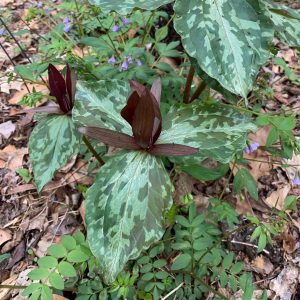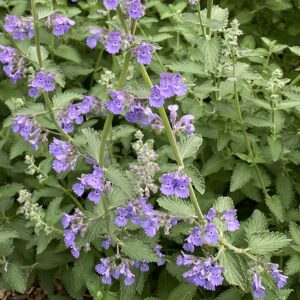 One of my favorite birds is the beautiful Meadowlark. When you’re driving in the countryside and you see cattle or horses in a grassy field, you’re in meadowlark habitat. Watch the tops of fence posts for a bird with a yellow front like a broad shield made of gold. In spring each male meadowlark adopts a bragging post, where he spends several hours each day in song. They are especially welcome at Creasey Mahan since we had none until the last few years when we planted native grasses in the big meadow and stopped mowing it. Now several pairs reside on the property.
One of my favorite birds is the beautiful Meadowlark. When you’re driving in the countryside and you see cattle or horses in a grassy field, you’re in meadowlark habitat. Watch the tops of fence posts for a bird with a yellow front like a broad shield made of gold. In spring each male meadowlark adopts a bragging post, where he spends several hours each day in song. They are especially welcome at Creasey Mahan since we had none until the last few years when we planted native grasses in the big meadow and stopped mowing it. Now several pairs reside on the property.
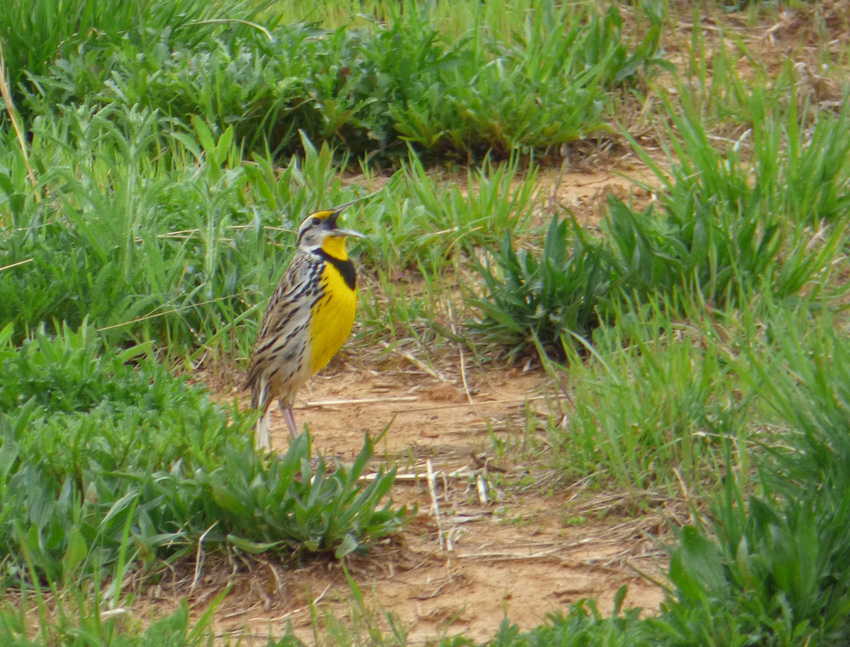 Face to face with a meadowlark, you’d think it was nearly all yellow, because the front-facing parts (throat and breast) are the color of daffodils. A black crescent on the chest, shiny as the satin lapels of a tuxedo, serves as contrast. Also from that vantage point, you see a bright yellow spot above and forward of each eye. If you find your meadowlark in the morning or late afternoon, you’ll probably notice that he’s facing the sun, as if his own warm color is drawn magnetically toward its source. Or perhaps he orients himself that way to maximize the impressiveness of his appearance.
Face to face with a meadowlark, you’d think it was nearly all yellow, because the front-facing parts (throat and breast) are the color of daffodils. A black crescent on the chest, shiny as the satin lapels of a tuxedo, serves as contrast. Also from that vantage point, you see a bright yellow spot above and forward of each eye. If you find your meadowlark in the morning or late afternoon, you’ll probably notice that he’s facing the sun, as if his own warm color is drawn magnetically toward its source. Or perhaps he orients himself that way to maximize the impressiveness of his appearance.
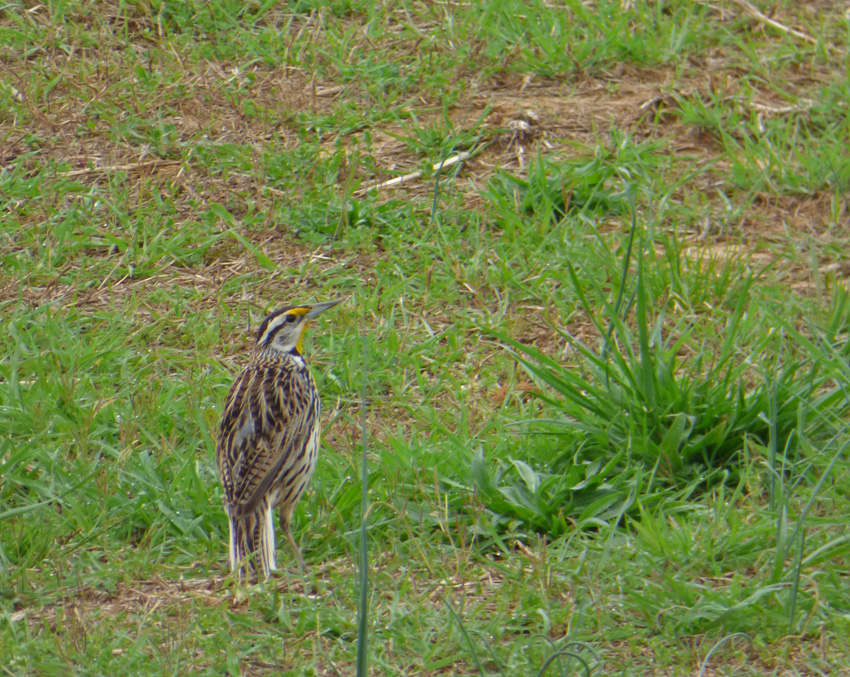 However, when he turns his back to you, he becomes nearly invisible, since from the top side, Meadowlarks make no impression at all. Their streaked backs so much resemble dried grass that a Meadowlark on the ground is almost impossible to spot from above. Hard luck for hawks, good luck for the Meadowlark! By the time the females arrive in the Spring, the males have pretty well worked out the boundaries of their estates. A successful male reigns over six or seven acres of pasture or hayfield. Singing is a primary means of territory establishment. Males also display to each other, and later to females, by tilting their bill upward and showing their bright yellow breast and black breast band. They will also engage in “jump flights”, where rival males leap into the air one after the other, fluttering their wings with tail cocked upward and feet dangling. Now his primary attention turns to mating. A male Eastern Meadowlark typically has two mates at a time, rarely three.
However, when he turns his back to you, he becomes nearly invisible, since from the top side, Meadowlarks make no impression at all. Their streaked backs so much resemble dried grass that a Meadowlark on the ground is almost impossible to spot from above. Hard luck for hawks, good luck for the Meadowlark! By the time the females arrive in the Spring, the males have pretty well worked out the boundaries of their estates. A successful male reigns over six or seven acres of pasture or hayfield. Singing is a primary means of territory establishment. Males also display to each other, and later to females, by tilting their bill upward and showing their bright yellow breast and black breast band. They will also engage in “jump flights”, where rival males leap into the air one after the other, fluttering their wings with tail cocked upward and feet dangling. Now his primary attention turns to mating. A male Eastern Meadowlark typically has two mates at a time, rarely three.
 I was surpised to learn that male and female Meadowlarks look alike. You can tell them apart by their behavior, but only the male sings. I like to imagine what the female Meadowlark sees when this knight in golden armor prances up close, carefully keeping his colorful front toward her, and points his bill up in the air to show off his yellow throat and swells out his yellow breast and flicks his wings above his back and leaps up and down to get her attention. If he succeeds in wooing her, they will mate, and the female will begin construction of a nest. She starts with a hoofprint or natural depression in the ground, which she shapes by digging with her bill. She lines the nest with fine grasses. She creates a roof by pulling the adjacent vegetation over her nest to form a dome, weaving it together with dried grasses that she carries to the site. She makes hundreds of trips bringing materials. When she’s finished, the thatched dome is waterproof. The nest looks like an ordinary tuft of green and brown weeds. It is open only on one side, and this entrance may also be hidden by overhanging weeds or by a roofed run. For birds who nest on the ground, in easy reach of predators, concealment is the best defense. Concealment does nothing however to protect them from their worst danger, the mower. The birds are in the middle of nesting during June and July, and if the field is mowed early, many nests are destroyed. We don’t mow Meadowlark Meadow during the summer months.
I was surpised to learn that male and female Meadowlarks look alike. You can tell them apart by their behavior, but only the male sings. I like to imagine what the female Meadowlark sees when this knight in golden armor prances up close, carefully keeping his colorful front toward her, and points his bill up in the air to show off his yellow throat and swells out his yellow breast and flicks his wings above his back and leaps up and down to get her attention. If he succeeds in wooing her, they will mate, and the female will begin construction of a nest. She starts with a hoofprint or natural depression in the ground, which she shapes by digging with her bill. She lines the nest with fine grasses. She creates a roof by pulling the adjacent vegetation over her nest to form a dome, weaving it together with dried grasses that she carries to the site. She makes hundreds of trips bringing materials. When she’s finished, the thatched dome is waterproof. The nest looks like an ordinary tuft of green and brown weeds. It is open only on one side, and this entrance may also be hidden by overhanging weeds or by a roofed run. For birds who nest on the ground, in easy reach of predators, concealment is the best defense. Concealment does nothing however to protect them from their worst danger, the mower. The birds are in the middle of nesting during June and July, and if the field is mowed early, many nests are destroyed. We don’t mow Meadowlark Meadow during the summer months.
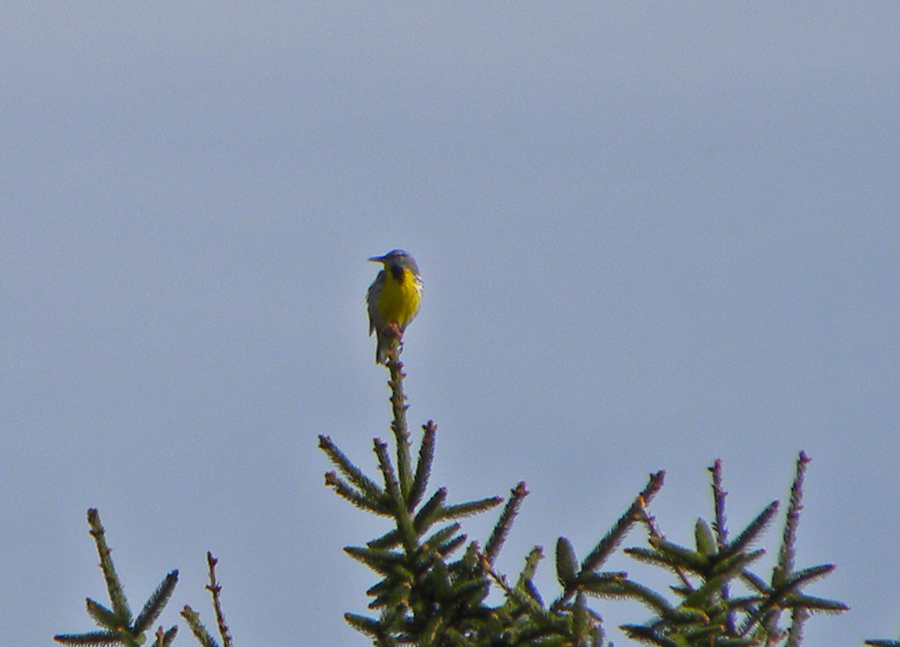 Eastern Meadowlarks are a declining species. The North American Breeding Bird Survey shows a severe rangewide decline estimated at between 2.9 percent and 14.8 percent per year from 1966 to 2010. Cumulative loss to population numbers may be as high as 75 percent during that time. Losses are due to their disappearing grassland habitat. Prairie is scarce in the eastern United States, and the kinds of farms that once hosted meadowlarks—small, family farms with pastureland and grassy fields—are being replaced by larger, row-cropping agricultural operations or by development. Early mowing, overgrazing by livestock, and the use of pesticides can also harm meadowlarks nesting on private lands.
Eastern Meadowlarks are a declining species. The North American Breeding Bird Survey shows a severe rangewide decline estimated at between 2.9 percent and 14.8 percent per year from 1966 to 2010. Cumulative loss to population numbers may be as high as 75 percent during that time. Losses are due to their disappearing grassland habitat. Prairie is scarce in the eastern United States, and the kinds of farms that once hosted meadowlarks—small, family farms with pastureland and grassy fields—are being replaced by larger, row-cropping agricultural operations or by development. Early mowing, overgrazing by livestock, and the use of pesticides can also harm meadowlarks nesting on private lands.

